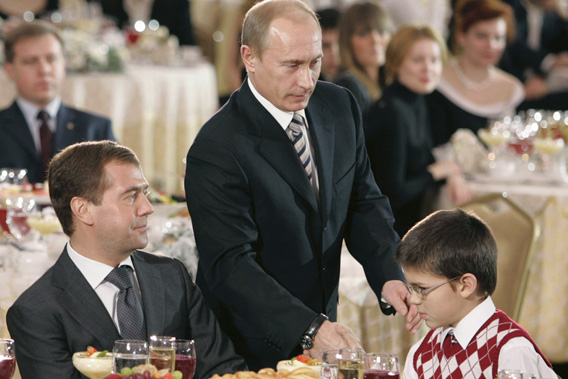 Russia's First Deputy Prime Minister Dmitry Medvedev (left) and President Vladimir Putin (center) attend the opening ceremony of the Year of the Family in Moscow's Kremlin, Dec. 24, 2007.
Russia's First Deputy Prime Minister Dmitry Medvedev (left) and President Vladimir Putin (center) attend the opening ceremony of the Year of the Family in Moscow's Kremlin, Dec. 24, 2007. Photo by Ria Novosti/Reuters
In February, the R&B group Boyz II Men performed a show in Moscow. Several Western media outlets claimed that the concert was done at the behest of Vladimir Putin, as part of his campaign to get Russians to make boomsa for the motherland?the idea being that the sweet, smooth grooves of ?I?ll Make Love to You? would be a nice warm-up act for Valentine?s Day.
This was something of a hoax: It?s not clear that Putin actually had anything to do with the booking. Or that the Moscow concert was anything other than a routine tour stop for the group. But the Boyz II Men story caught on because it fit in with some of the outlandish measures Russia has taken in recent years to boost its low fertility rate.
Putin began his natalist campaign in 2008, declaring it the "Year of the Family.? There were billboards and placards encouraging people to have children. A park in Moscow debuted special benches designed to gently slide couples closer together, all the better for canoodling. July 8 was designated ?Family, Love, and Fidelity Day,? a new holiday created to encourage family formation. This was the third holiday Russia had created for such a purpose: In 2007, Sept. 12 was named ?Family Contact Day,? a day on which workers were given time off and encouraged to, like, totally do it. Women having babies nine months later, on ?Give Birth to a Patriot on Russia Day,? won fabulous prizes ranging from TVs to an SUV.
Russia has also instituted some more traditional natalist policies; for instance the government began a program that pays mothers $10,000 for the birth of a second child. Putin?s stated goal is that ?the three-child family should become the norm in Russia.?
He is not the first Russian leader to worry about the country?s fertility rate. In 1944, as Russians were being ground up in the war against Germany, Josef Stalin created the ?Motherhood Medal? for women who bore six children. (That was for the First Class order; only five children were required for Second Class. You can pick a medal up pretty cheap on eBay.) In 1955, Nikita Khrushchev surveyed the nascent Western overpopulation mania and declared it a ?cannibalistic theory? invented by ?bourgeois ideology.? He continued: ?Their concern is to cut down the birth rate, reduce the rate of population increase. It is quite different with us, comrades. If about 100 million people were added to our 200 million, even that would not be enough.?
The old Soviet regime rolled out a series of childbearing incentives: First, lump-sum payments for the birth of children. Then increased state benefits for families with children, including bonuses for housing and work allowances. In 1981 the Politburo offered women a full year of partially paid leave for having a baby. In 1986 it upped the ante to a year-and-a-half ?s worth of leave.
None of it worked, then or now. The Soviet Union?s fertility rate?that?s the average number of children a woman bears during her lifetime?declined throughout the ?50s, ?60s, and ?70s. The only brief period of increase came during the late 1980s. And then it resumed decline.
Putin?s initiatives haven?t fared any better. The Russian government declared demographic victory in 2012 because there was an increase in the crude number of births. ?The demographic programs enacted in the past decade are, thank God, working,? Putin said. But most demographers believe this is a statistical ghost?the slight spike in fertility rates during the late ?80s created a relatively fat cohort of women now in their prime childbearing years. So while the number of births has increased thanks to the size of this cohort, Russia?s total fertility rate has remained very low. The CIA World FactBook puts it at 1.61. The replacement fertility rate?the number of births the average woman must have in order to hold population constant?is 2.1. Which is why Russia?s population has been declining for several years now. And will continue to decline in another year or two, once the statistical ghost has been given up.
Russia?s situation isn?t unique. Fertility rates began falling in Western, industrialized countries in 1968. By 1975, every Western First World nation was below the replacement rate. Over the course of the next two decades, massive fertility decline spread worldwide: In 1979, the global fertility rate was 6.0; today it?s 2.52 and still declining. While the lay press has spent the last 30 years fretting about increasing world population, the academic community has been largely concerned with the opposite. Because when you look at just the top-line number you miss the more important, rate-based trends. So today, most population models suggest we are currently at ?peak child,? as economist Hans Rosling puts it. That is to say, the world currently has about 2 billion children and that number is likely to decline over time, not increase. Which means that all of our remaining population gains?in terms of the absolute number?will come from increased life expectancy.
Which in turn means that the world is actually headed toward population decline. I?ve written a whole book about this?What to Expect When No One?s Expecting?but don?t take my word for it. Slate contributor Jeff Wise wrote an excellent piece distilling the academic research just a few months ago.
Source: http://feeds.slate.com/click.phdo?i=4c187f4865ba65d759f7a0d9c90a0dd1
yahoo finance iOS 6.1 BlackBerry Kwame Harris Vine dr oz sag awards
No comments:
Post a Comment
Note: Only a member of this blog may post a comment.